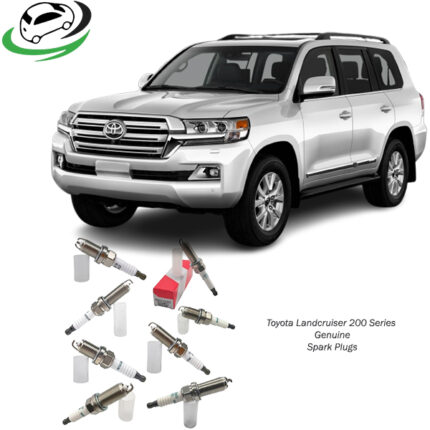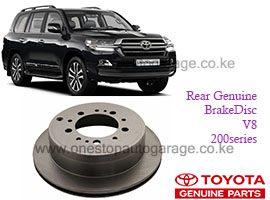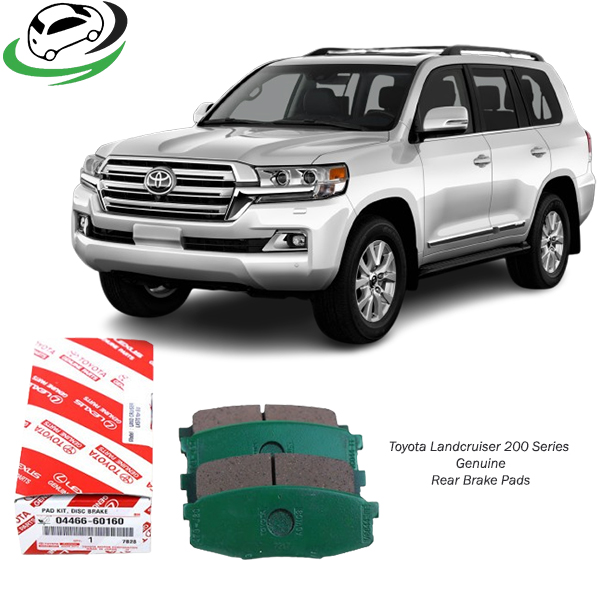-13%
Get Toyota Land Cruiser 200 Series Rear Brake Pads 04466-60160
Brake pads are crucial components of a vehicle’s braking system, designed to provide the necessary friction to slow down or stop a vehicle. While front brake pads generally take on more braking force, rear brake pads play an equally vital role in stabilizing and evenly distributing braking pressure. Using genuine rear brake pads ensures optimal braking performance, safety, and longevity for your vehicle. Genuine brake pads are manufactured to meet specific vehicle requirements, ensuring they perform efficiently under a range of driving conditions.
The Function of Rear Brake Pads
- Friction Generation for Stopping Power The primary function of rear brake pads is to create friction that slows down the vehicle’s wheels. When the brake pedal is pressed, hydraulic fluid pushes the calipers to press the brake pads against the brake rotor (also called the brake disc). This contact generates friction, which helps to slow down the rotation of the wheels. Rear brake pads are specially designed to handle the lesser but still significant braking force applied to the rear axle.
- Heat Absorption and Dissipation Braking generates a tremendous amount of heat due to the friction between the brake pads and rotors. Rear brake pads are designed to absorb and dissipate this heat efficiently, preventing brake fade—a condition where the braking system loses its effectiveness due to excessive heat buildup. Genuine rear brake pads are made from high-quality materials that ensure proper heat management, reducing the risk of brake fade.
- Balancing Braking Force While front brakes bear the brunt of the braking load (typically around 60-70%), rear brake pads play an essential role in balancing the overall braking force. This balance prevents the vehicle from skidding or losing control during hard braking. Rear brake pads also prevent the front brakes from wearing out prematurely by sharing the braking load. Genuine rear brake pads are engineered to deliver this balance, ensuring safe and stable braking performance.
- Providing Stability During Braking Rear brake pads contribute significantly to vehicle stability, especially during emergency braking or on slippery surfaces. By engaging the rear brakes, they help prevent the rear wheels from locking up, maintaining control of the vehicle. Genuine rear brake pads are designed to work in harmony with the vehicle’s ABS (Anti-lock Braking System), further improving control and safety during braking.
- Minimizing Noise and Vibration Genuine rear brake pads are engineered with advanced materials to reduce noise, vibration, and harshness (NVH) during braking. They are designed to minimize squealing or grinding noises, which are common with lower-quality aftermarket brake pads. Proper fitting and material quality ensure a smoother, quieter braking experience.
Types of Genuine Rear Brake Pads
- Semi-Metallic Brake Pads These brake pads are made from a mixture of metals (such as steel, copper, and iron) and other composite materials. Semi-metallic rear brake pads are known for their durability and ability to handle high temperatures, making them ideal for heavy-duty vehicles or high-performance applications. However, they may produce more noise and wear down brake rotors faster than other types.
- Ceramic Brake Pads Ceramic rear brake pads are made from a combination of ceramic fibers, bonding agents, and small amounts of metal. These pads offer quieter braking performance and produce less brake dust compared to semi-metallic pads. Ceramic pads are ideal for everyday driving, providing a smooth, stable braking experience with minimal noise. Genuine ceramic brake pads offer longer lifespan and consistent performance, even in extreme temperatures.
- Organic Brake Pads Organic rear brake pads, also known as non-asbestos organic (NAO) pads, are made from a mixture of fibers, fillers, and resin. These pads are softer and quieter but tend to wear out faster than ceramic or semi-metallic pads. Organic pads are often used in lighter vehicles or vehicles that do not require aggressive braking. Genuine organic brake pads provide a quieter, low-dust option while still offering good stopping power.
Benefits of Using Genuine Rear Brake Pads
- Enhanced Safety The most significant advantage of using genuine rear brake pads is the safety they provide. Genuine pads are rigorously tested to meet manufacturer specifications, ensuring they deliver optimal braking performance. They reduce stopping distances and help maintain vehicle control, especially in emergency situations. Substandard or non-genuine brake pads may compromise braking performance, increasing the risk of accidents.
- Perfect Fit and Compatibility Genuine rear brake pads are designed to fit precisely with your vehicle’s braking system. This ensures a proper seal between the pads and the rotors, which is critical for consistent and reliable braking. A proper fit also helps to reduce wear on other components, such as the calipers and rotors, extending the life of your braking system. Non-genuine pads may not fit as well, leading to poor performance and uneven wear.
- Durability and Longevity Genuine rear brake pads are made from high-quality materials designed to withstand the stress of braking over long periods. They offer superior wear resistance and heat tolerance, ensuring a longer lifespan compared to aftermarket options. This durability translates to fewer replacements and lower overall maintenance costs in the long run.
- Reduced Brake Dust Brake dust is a byproduct of friction and can accumulate on the vehicle’s wheels, leading to unsightly stains and potential damage to the wheel finish. Genuine rear brake pads, especially ceramic ones, are designed to produce less brake dust, keeping your wheels cleaner for longer. This not only improves the appearance of your vehicle but also reduces the need for frequent wheel cleaning.
- Minimized Noise and Vibration One of the most common complaints about aftermarket brake pads is the noise they generate during braking. Genuine rear brake pads are engineered to reduce noise and vibration, providing a quieter and more comfortable driving experience. This is especially important for daily commuters or those who frequently drive in urban environments where stop-and-go traffic is common.
- Consistent Performance Genuine rear brake pads offer consistent braking performance under various driving conditions. Whether you are driving in extreme temperatures, heavy traffic, or on long downhill stretches, genuine brake pads maintain their effectiveness. This reliability is crucial for maintaining control and safety during challenging driving scenarios.
- Improved Heat Dissipation High-quality materials used in genuine rear brake pads help dissipate heat more effectively, preventing brake fade. This ensures that your brakes remain responsive even during prolonged or heavy braking. Proper heat dissipation also reduces the risk of rotor warping, which can lead to costly repairs.
Maintenance Tips for Genuine Rear Brake Pads
To ensure the longevity and optimal performance of your rear brake pads, regular maintenance is essential. Here are some tips to keep in mind:
- Regular Inspection It’s important to inspect your rear brake pads regularly to check for wear. Most brake pads have wear indicators, which produce a squealing noise when the pads are worn down. If you hear this noise or notice a decrease in braking performance, it’s time to have the brake pads inspected and replaced if necessary.
- Replace in Pairs When replacing rear brake pads, it’s essential to replace both sets (left and right) at the same time. This ensures even braking performance and prevents uneven wear on the brake rotors.
- Brake Fluid Check Brake pads work in conjunction with the hydraulic braking system, which relies on brake fluid to transfer the force from the pedal to the brakes. Make sure to check your brake fluid levels regularly and replace the fluid as recommended by the manufacturer to maintain optimal braking performance.
- Rotor Inspection The brake rotors should be inspected whenever you replace the rear brake pads. If the rotors are worn, warped, or damaged, they should be resurfaced or replaced to ensure proper contact with the new brake pads. Failing to address rotor issues can lead to uneven wear and reduced braking effectiveness.
- Drive Smoothly Abrupt or aggressive braking can wear down rear brake pads more quickly. Try to anticipate stops and brake gradually to reduce wear on the brake pads and extend their lifespan.
- Use Genuine Parts Always opt for genuine rear brake pads that are designed for your specific vehicle. Using aftermarket parts may result in poor performance, shorter lifespan, and potentially higher maintenance costs.
Signs Your Rear Brake Pads Need Replacement
There are several signs that indicate your rear brake pads may need to be replaced:
- Squealing or Squeaking Noise A high-pitched squealing noise during braking is a common sign that your brake pads are worn and need replacement. Many brake pads have built-in wear indicators that produce this sound as an alert.
- Longer Stopping Distances If you notice that it takes longer for your vehicle to come to a stop, it may be a sign that the rear brake pads are worn out. This can be dangerous and should be addressed immediately.
- Vibration or Pulsation If you feel a vibration or pulsation in the brake pedal when braking, it could indicate that the rear brake pads are worn unevenly or that the rotors are warped.
- Low Brake Pad Thickness Visually inspecting the brake pads can also help determine if they need replacement. If the brake pad material is less than 3mm thick, it’s time to replace them.
- Brake Warning Light Some vehicles are equipped with a brake warning light that illuminates when the brake pads are worn. If this light comes on, it’s important to have your brakes inspected as soon as possible.
Conclusion
Genuine rear brake pads are essential for maintaining the safety, performance, and longevity of your vehicle’s braking system. By using genuine pads, you ensure optimal fit, durability, and braking efficiency. Regular maintenance, including timely inspection and replacement of rear brake pads, is critical for preventing potential issues and ensuring a safe driving experience. Whether you are navigating daily traffic or facing emergency braking situations, genuine rear brake pads offer the reliability and peace of mind every driver needs.
Follow us on Facebook for more parts.



